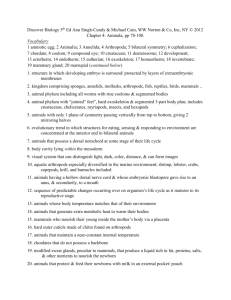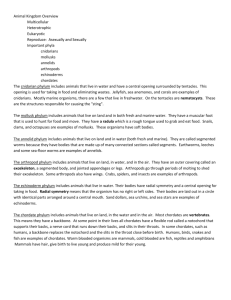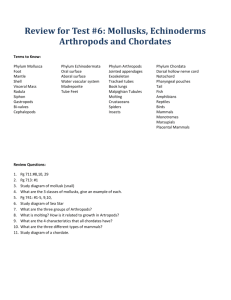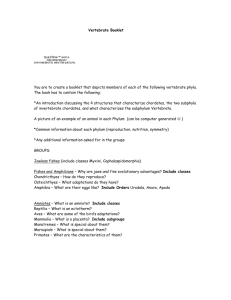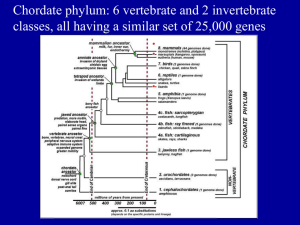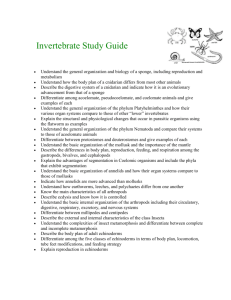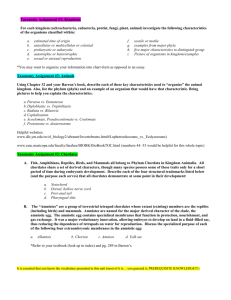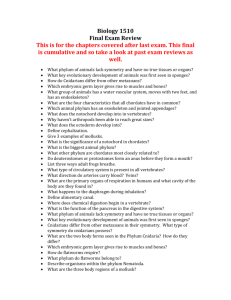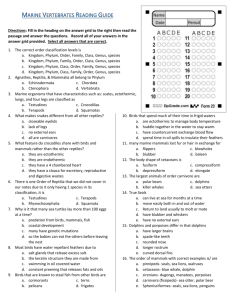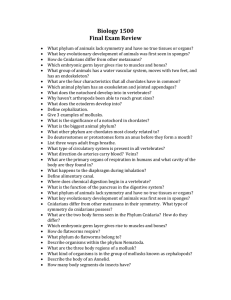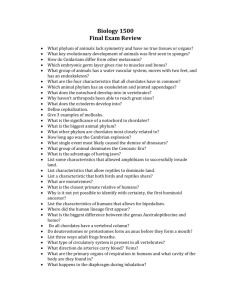Study Guide for 2nd Semester Final Exam for Biology II – May 2010
advertisement
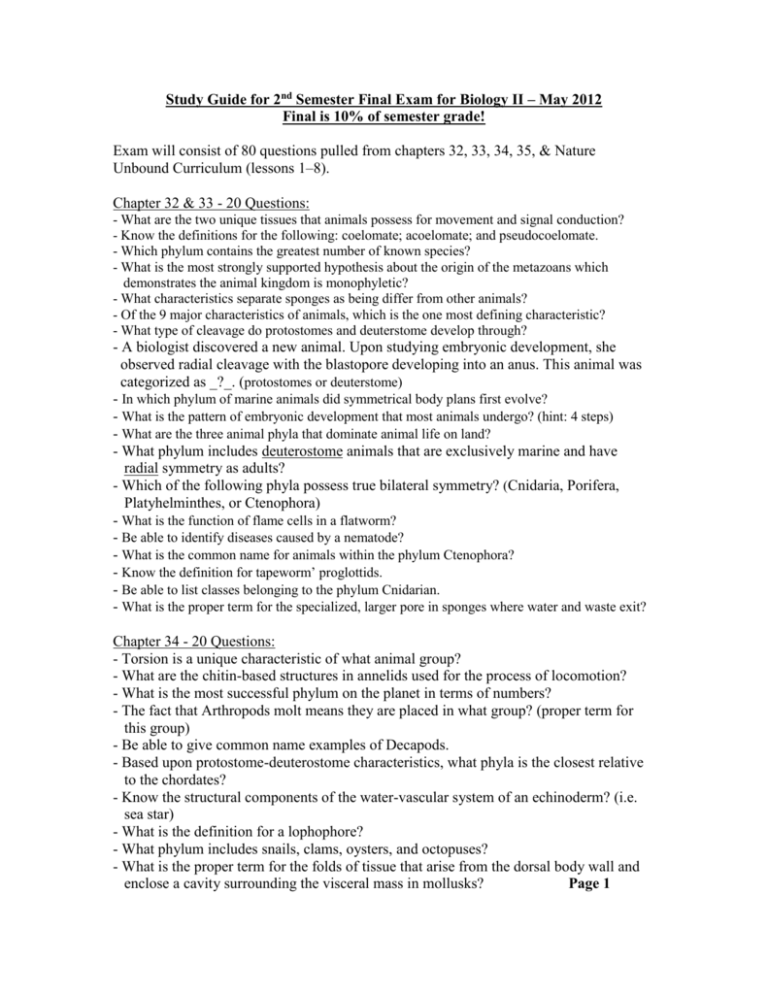
Study Guide for 2nd Semester Final Exam for Biology II – May 2012 Final is 10% of semester grade! Exam will consist of 80 questions pulled from chapters 32, 33, 34, 35, & Nature Unbound Curriculum (lessons 1–8). Chapter 32 & 33 - 20 Questions: - What are the two unique tissues that animals possess for movement and signal conduction? - Know the definitions for the following: coelomate; acoelomate; and pseudocoelomate. - Which phylum contains the greatest number of known species? - What is the most strongly supported hypothesis about the origin of the metazoans which demonstrates the animal kingdom is monophyletic? - What characteristics separate sponges as being differ from other animals? - Of the 9 major characteristics of animals, which is the one most defining characteristic? - What type of cleavage do protostomes and deuterstome develop through? - A biologist discovered a new animal. Upon studying embryonic development, she observed radial cleavage with the blastopore developing into an anus. This animal was categorized as _?_. (protostomes or deuterstome) - In which phylum of marine animals did symmetrical body plans first evolve? - What is the pattern of embryonic development that most animals undergo? (hint: 4 steps) - What are the three animal phyla that dominate animal life on land? - What phylum includes deuterostome animals that are exclusively marine and have radial symmetry as adults? - Which of the following phyla possess true bilateral symmetry? (Cnidaria, Porifera, Platyhelminthes, or Ctenophora) - What is the function of flame cells in a flatworm? - Be able to identify diseases caused by a nematode? - What is the common name for animals within the phylum Ctenophora? - Know the definition for tapeworm’ proglottids. - Be able to list classes belonging to the phylum Cnidarian. - What is the proper term for the specialized, larger pore in sponges where water and waste exit? Chapter 34 - 20 Questions: - Torsion is a unique characteristic of what animal group? - What are the chitin-based structures in annelids used for the process of locomotion? - What is the most successful phylum on the planet in terms of numbers? - The fact that Arthropods molt means they are placed in what group? (proper term for this group) - Be able to give common name examples of Decapods. - Based upon protostome-deuterostome characteristics, what phyla is the closest relative to the chordates? - Know the structural components of the water-vascular system of an echinoderm? (i.e. sea star) - What is the definition for a lophophore? - What phylum includes snails, clams, oysters, and octopuses? - What is the proper term for the folds of tissue that arise from the dorsal body wall and enclose a cavity surrounding the visceral mass in mollusks? Page 1 - The organ that is responsible for secreting cocoons in the oligochaetes is known as the _?_. - Know examples of mollusks that live on land. - Squids and octopuses move by means of water movement through which particular parts of their body? - How are nitrogenous waste removed in mollusks? (name the structure) - What is the proper term for the partitions that separate the segments of the annelid body? - What is the most successful class of arthropods? - What is the proper term for the passage of an arthropod through stages from egg to adult? - In arthropods, locomotion is accomplished by muscles that work against the _?_. - Air passage into the trachea of most insects is controlled by the closing and opening of valves, which operate special openings called _?_. - A sieve-like plate on the echinoderms surface through which water enters the vascular system and flows to the ring canal through a tube is properly called _?_. Chapter 35 - 20 Questions: - A single-loop closed circulatory system is a characteristic of which vertebrate group? - The _?_ of the body fish evolves to counter the effects of increased bone density. - From which group of fish did the amphibians originate? - What was the first group of animals to utilize an amniotic egg? - What are the nearest relatives of the chordates? (Hint: have deuterostome development) - What was the most important key evolutionary advance that allowed the reptiles to live in a variety of habitats? - Feathers are unique to birds; however, birds also share what feature with reptiles? - Tunicates are chordates but are very different from the other two subphyla. What features associated them with the other chordates? - The defining characteristics of mammals are _?_. (know top three) - The mucous sheet produced by the endostyle traps the microscopic food particles in the water. This sheet is located in the pharynx of what animal? - Small, fishlike marine chordates, pointed at both ends with no distinguishable head, in which the notochord runs the entire length of the nerve cord, are called _?_. - Most bony fishes have a hard plate that covers the gills on each side of the head called the _?_. - Birds, like mammals, can regulate their body temperatures within close limits. Therefore birds and mammals are called _?_. - Be able to list the five groups of chordates from most to least diversity of species. - What group of living reptiles care for their young and have a four-chambered heart, as birds do? - The most successful terrestrial vertebrates that invaded the air are _?_. - Monotremes differ from the other mammals in what trait / characteristic? - The only marsupial mammal living (natively in the wild) in North America is the _?_. - In humans one pair of pharyngeal gill slits become the tube-shaped organ called the _?_. - Our own species, _?_, appears to have evolved in Africa less than 200,000 years ago. Page 2 Nature Unbound - 20 Questions: - Define ecology. - Be able to make a statement that best describes conservation’s role in society. - Ecologist work through the use of scientific method; be able to describe that process. - Know the reproductive strategies of Mead’s milkweed. - Be able to explain which type of reproductive strategy would give an organism the greatest genetic diversity. - Be able to explain why genetic diversity is so important to a species survival. - Be able to list and explain limiting factors to a population’s carrying capacity. - What are the three key measurements of a population that ecologists make? - What would happen, over time, if two species occupied the exact same niche? - What would be the impact to an ecosystem if all the large mammalian predators were eliminated? - Know the relationship between the size of a population and the size of its home range in regards to the likelihood of a species to go extinct. - Know the number one factor causing extinction of most species. - Why are there usually fewer than five levels in an energy pyramid? - Be able to explain how the flow of energy in a food web (to the remaining components) if one component was reduced. - Know details about how the following abotic cycles operate: water; nitrogen; carbon; & phosphorus. (Be able to outline and describe a complete cycle for each). - Know how a community’s stability is related to biodiversity. - Be able to predict secondary succession stages that would occur to an oak – hickory forest ecosystem if a F-5 tornado tore a quarter mile path through the forest right down to bare soil. Page 3
